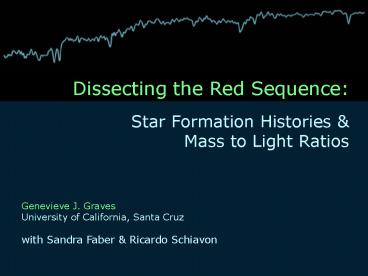Dissecting the Red Sequence: Star Formation Histories PowerPoint PPT Presentation
1 / 21
Title: Dissecting the Red Sequence: Star Formation Histories
1
Dissecting the Red Sequence Star Formation
Histories Mass to Light Ratios
Genevieve J. Graves University of California,
Santa Cruz with Sandra Faber Ricardo Schiavon
2
binning ? and ?Mdyn/L
at fixed ?, Re variations in Ie ? variations in
Mdyn/L
bin by ? and ?Mdyn/L
3
the metallicity hyperplane
4
MHP maps onto FP X-section
(Age, Fe/H) (?, ?Mdyn /L)
5
variations in Mdyn /L within Re
stellar population (age, Z)
6
dynamical mass estimator
SAURON Survey
SLACS Survey
Cappellari et al. (2006) - IFU data, dynamical
models
Bolton et al. (2007) - strong lensing
UW May 27, 2008
7
variations in Mdyn /L within Re
stellar population (age, Z)
8
the metallicity hyperplane
9
M?/L vs. Mdyn /L
Mdyn / L
(SSP)
log Mdyn / L
log M / L
10
variations in Mdyn /L within Re
stellar population (age, Z)
11
two tilts of the FP
FP midplane
Stellar Population M?/L
log Re
M?/L ? ?
residual tilt Mdyn / M?
log Re
log ?
12
M?/L vs. Mdyn /L
Mdyn / L
log Mdyn / L
log M / L
13
observational conclusions
- ETG star formation histories 2-D parameter
space - (variations with ? and with ?Mdyn/L)
- 2-D family of star formation histories
X-section of FP - Stellar population effects cannot account for
observed tilt - of the FP, or the observed thickness of the FP
- variations in the IMF or central DM fraction
required - high Mdyn/M? correlated with short duration
star formation - The two tilts of the FP
- Stellar population effects (M?/L) and variable
IMF or DM - fraction (Mdyn/M?) tilts rotate the FP around
different axes
14
variations in the IMF?
more at low end
M/L from Chabrier IMF
need some galaxies with higher M/L
M log (dN / d log M)
more at high end
high end more attractive to match Mg/Fe
0.1 1 10 100
log M (M?)
15
variation in DM fraction?
? Mdyn /L is measured within Re
- genuine lack of stellar mass for given halo
mass - (low star formation efficiency)
- - early truncation of star formation through
quenching? - (by AGN or massive halo)
- redistribution of stellar and dark matter
inside/outside Re - - gas-rich vs. dry mergers?
16
low sf efficiency halo quenching?
early quenching low Ie, high Mdyn/L
Cattaneo et al. (2008)
late quenching high Ie, low Mdyn/L
naturally produces correlation between Mdyn /L ,
short duration star formation _at_ fixed ?
0 2 4 6 8
z
17
low sf efficiency AGN feedback?
Galaxy w/ Powerful Radio Jets _at_
z2.4 OIII?5007 emission aligned w/
radio lobes large outflow velocities
outflow mass-loading and lifetime can carry out
few x 1010 M?
SF truncated in high Mdyn/L objects
18
redistribution of stars?
gas fraction of major-merger changes Mdyn / M?
gas fraction
1
0.2 dex
fgas varies w/ mass ? contributes to FP tilt
40
log Mdyn / M?
could also have fgas variations _at_ fixed ? ? FP
thickness
long-duration SF ? gas-rich mergers
R / Re
Robertson et al. (2006)
19
future work
- test variable IMF vs. variable DM fraction
- - look at galaxy cores where DM should be
unimportant - - look for central starburst contribution from
gas-rich merger - (2-component galaxy light profiles)
- chemical evolution models
- - what forms of variable IMFs match both Mdyn/M?
and Mg/Fe? - the role of environment
- - both merger and massive halo explanations
imply environment - plays a role
- - relations for central galaxies vs.
satellites
20
M?/L vs. Mdyn /L
Mdyn / L
(SSP)
log Mdyn / L
log M / L
21
M?/L from Age, Fe/H

